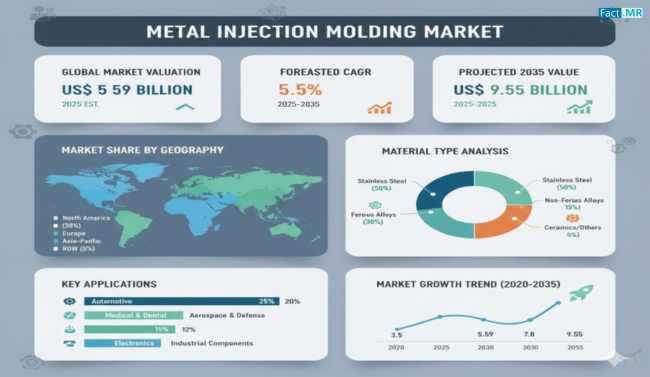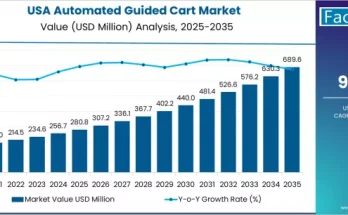The metal injection molding (MIM) market is transforming the landscape of precision component manufacturing across industries. By combining the design flexibility of plastic injection molding with the strength and integrity of metal, MIM technology has emerged as a critical process for producing complex, high-performance parts at scale. Industries ranging from automotive and electronics to medical and defense are increasingly adopting MIM for its cost efficiency, design versatility, and superior material properties.
Market Overview:
Metal injection molding is a hybrid manufacturing process that blends fine metal powders with polymer binders to create feedstock suitable for injection molding. The molded components are then debound and sintered to achieve high-density metal parts that rival those made through traditional manufacturing techniques such as machining or casting.
The growing demand for miniaturized, durable, and complex components has positioned MIM as a preferred manufacturing method for industries seeking efficiency without compromising strength or accuracy. The technology is particularly valued for producing small, intricate parts that are difficult or expensive to fabricate using conventional methods.
Sustainability is also playing a crucial role in shaping the MIM market. The process enables near-net-shape production, minimizing material wastage and energy consumption. Manufacturers are investing in cleaner feedstock materials, advanced sintering technologies, and automation to enhance productivity and reduce environmental impact.
With ongoing innovation and broader adoption across end-use industries, MIM is steadily becoming a cornerstone of modern industrial production.
Regional Insights:
North America leads in MIM adoption due to its advanced manufacturing infrastructure and emphasis on high-precision engineering. The region’s strong presence in aerospace, defense, and medical device manufacturing continues to drive demand for complex metal components produced through MIM technology.
Europe follows closely, benefiting from a robust automotive sector and stringent sustainability regulations. European manufacturers are increasingly integrating MIM into lightweight vehicle component production, aiming for enhanced fuel efficiency and reduced emissions. The focus on technological refinement and eco-friendly manufacturing practices has also positioned Europe as a hub for innovation in powder metallurgy.
Asia-Pacific represents one of the fastest-growing regions for the MIM market. With strong electronics and automotive industries in countries like China, Japan, South Korea, and India, the region is becoming a global center for MIM component manufacturing. The availability of cost-effective raw materials, skilled labor, and supportive government initiatives for industrial growth are further boosting the regional market.
Latin America and the Middle East & Africa are witnessing gradual market expansion driven by rising industrialization, growing medical technology adoption, and increased investment in energy and defense sectors.
Innovations and Regulatory Trends:
Technological innovation is at the heart of the metal injection molding market’s evolution. Advancements in binder systems, powder metallurgy, and 3D printing integration are improving process efficiency and material performance. These developments allow for tighter dimensional tolerances, faster production cycles, and greater material versatility.
Manufacturers are increasingly focusing on developing MIM feedstocks compatible with stainless steel, titanium, and magnetic alloys to cater to specific application needs. The combination of MIM with additive manufacturing (AM) technologies is also emerging as a game changer, enabling rapid prototyping and custom part production with reduced lead times.
From a regulatory standpoint, adherence to quality and safety standards in industries like aerospace and healthcare has become critical. MIM producers are aligning their operations with ISO and ASTM standards, ensuring material traceability, consistency, and compliance with environmental norms. Additionally, sustainability-focused initiatives promoting recyclable materials and energy-efficient processes are shaping the competitive landscape.
Key Trends & Forecast:
The metal injection molding market is set to evolve through several key trends:
- Miniaturization of Components: The demand for small, intricate components in electronics, medical devices, and consumer goods is propelling the adoption of MIM technology.
- Material Advancements: Ongoing research in alloy development is expanding the application scope of MIM, offering improved strength, corrosion resistance, and performance.
- Automation and Smart Manufacturing: Integration of robotics and IoT-enabled systems in MIM production lines is enhancing process control, precision, and scalability.
- Sustainability and Waste Reduction: MIM’s near-net-shape capability aligns with global sustainability goals, minimizing material waste and energy consumption.
- Rise of Electric Mobility: The electric vehicle (EV) industry is emerging as a major consumer of MIM parts, particularly for drive systems, sensors, and precision connectors.
These trends underscore the growing relevance of MIM in industries seeking to balance high-performance engineering with cost-effective, sustainable production.
Applications & End-Use Outlook:
The versatility of the MIM process allows it to cater to a wide range of applications across diverse industries:
- Automotive: MIM is extensively used in producing engine components, transmission parts, turbocharger vanes, and structural elements requiring strength and dimensional accuracy.
- Medical Devices: Precision instruments, orthodontic brackets, and surgical components benefit from MIM’s ability to produce biocompatible, high-strength parts.
- Consumer Electronics: Smartphone components, connectors, and camera parts rely on MIM for their compact design and consistent performance.
- Aerospace and Defense: Lightweight, durable components essential for aircraft systems and defense mechanisms are increasingly being manufactured through MIM.
- Industrial and Power Tools: MIM enables the cost-effective production of gears, levers, and intricate mechanisms used in industrial machinery and equipment.
The growing convergence of MIM with digital manufacturing and quality control systems is expanding its reach into new sectors such as renewable energy and telecommunications.
Competitive Landscape:
The global MIM market is highly competitive, with manufacturers focusing on innovation, quality assurance, and strategic collaborations. Companies are expanding production capacities, forming partnerships, and investing in automation to improve throughput and cost efficiency.
Customization and material diversification are becoming central to competitive strategy, as end users demand tailored solutions for specialized applications. Collaboration between material scientists, engineers, and end-use industries is fostering continuous product enhancement and technical advancement.
Additionally, companies are adopting sustainable practices, such as recycling metal powders and utilizing energy-efficient sintering technologies, to align with environmental standards and global green manufacturing initiatives.
Conclusion:
The metal injection molding market stands at the forefront of industrial innovation, bridging the gap between traditional manufacturing and modern precision engineering. With its ability to produce complex, high-performance components efficiently, MIM is becoming an indispensable technology across multiple sectors.
As industries continue to embrace lightweight, sustainable, and high-precision design philosophies, MIM’s relevance will only deepen. Forward-thinking manufacturers that invest in advanced materials, automation, and eco-conscious production will be best positioned to lead in this dynamic and evolving market.
Browse Full Report – https://www.factmr.com/report/487/metal-injection-molding-market



